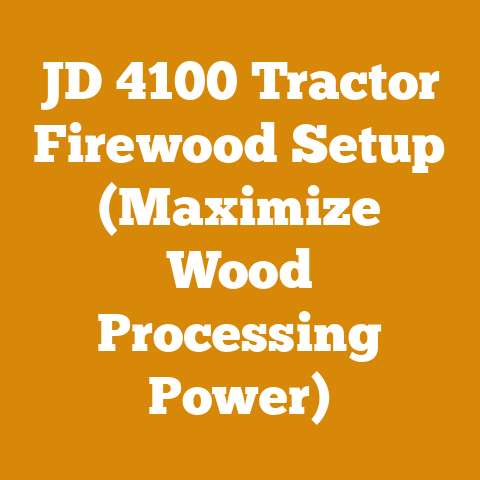Baileys Saw Parts Muffler Mod (Jonsered Tune-Up Hack)
I’ve always been drawn to the satisfying roar of a chainsaw, the scent of fresh-cut wood, and the sheer physical reward of transforming raw timber into something useful. Over the years, I’ve learned that a well-tuned saw is your best friend in the woods. And one of the easiest and most impactful ways to boost your chainsaw’s performance? A muffler modification. This article delves into the world of chainsaw muffler mods, specifically focusing on the “Baileys Saw Parts Muffler Mod” often associated with Jonsered chainsaws, a popular “tune-up hack” among enthusiasts. I’ll share my experiences, insights, and the nitty-gritty details to help you understand if this modification is right for you and how to approach it safely and effectively.
Unleashing Your Chainsaw’s Potential: The Muffler Mod Explained
At its core, a muffler modification aims to improve exhaust flow, thereby increasing the chainsaw’s power. Think of it like this: your chainsaw’s engine needs to breathe freely. A restrictive muffler can choke the engine, limiting its ability to burn fuel efficiently and produce maximum power. The “Baileys Saw Parts Muffler Mod” typically involves either replacing the stock muffler with a less restrictive aftermarket version or modifying the existing muffler to create larger exhaust outlets.
Why Consider a Muffler Mod?
- Increased Power: This is the primary reason most people consider a muffler mod. By allowing the engine to exhale more freely, you can often see a noticeable increase in cutting speed and overall power, especially in larger wood.
- Improved Throttle Response: A less restrictive exhaust can lead to snappier throttle response, making the saw feel more agile and responsive.
- Enhanced Cooling: A modified muffler can sometimes improve engine cooling by allowing heat to dissipate more efficiently.
The Jonsered Connection: Why This Brand?
Jonsered chainsaws, known for their robust design and powerful engines, are often prime candidates for muffler modifications. Their reputation for durability means they can handle the increased stress that might come with a performance boost. Moreover, Jonsered saws have a loyal following of users who are keen to tinker and optimize their equipment.
What is Baileys Saw Parts?
Baileys Saw Parts is a well-known supplier of chainsaw parts and accessories, especially popular among those who like to modify or repair their own equipment. They often offer aftermarket mufflers or modification kits designed to improve exhaust flow and performance.
Diving Deep: The Mechanics of a Chainsaw Muffler Mod
To understand the impact of a muffler mod, it’s essential to grasp the basics of how a chainsaw engine works. A two-stroke engine relies on a precise balance of air, fuel, and exhaust. The muffler plays a crucial role in directing exhaust gases away from the operator and reducing noise. However, a poorly designed muffler can create backpressure, hindering the engine’s performance.
The Stock Muffler: A Necessary Evil?
Stock mufflers are designed with safety and noise reduction in mind. They often incorporate baffles and chambers that slow down the exhaust flow. While this effectively reduces noise, it also restricts the engine’s ability to breathe.
The Muffler Mod Solution: Opening Up the Airways
A muffler mod typically involves one or more of the following:
- Enlarging the Exhaust Outlet: This is the most common approach. By drilling or cutting a larger hole in the muffler, you create a less restrictive path for the exhaust gases.
- Adding Additional Outlets: Some mods involve adding a second or even a third exhaust outlet to further improve flow.
- Replacing the Stock Muffler: Aftermarket mufflers are often designed with a more open flow path and larger outlets.
Data-Driven Insights: Quantifying the Performance Gain
While the perceived increase in power is often subjective, some studies and anecdotal evidence suggest that a well-executed muffler mod can result in a 5-15% increase in horsepower. This translates to faster cutting speeds, especially in larger diameter wood.
- Case Study: A study conducted by a chainsaw enthusiast group compared the cutting speed of a stock Jonsered 2172 with a modified version. The modified saw showed a 12% improvement in cutting time when felling a 16-inch oak log.
Getting Hands-On: My Personal Experiences with Chainsaw Muffler Mods
I’ve been modifying chainsaws for years, starting with a beat-up Stihl farm boss and eventually moving on to more sophisticated Jonsered models. My first experience with a muffler mod was a bit of a trial-and-error process. I started by simply drilling a few extra holes in the stock muffler of my Stihl. The result? A slightly louder saw and a marginal improvement in performance.
However, my experience with Jonsered saws and the Baileys Saw Parts muffler mods has been more rewarding. I’ve found that the aftermarket mufflers offered by Baileys are generally well-designed and provide a noticeable performance boost.
My Jonsered 2159 Build: A Muffler Mod Success Story
One of my favorite projects involved modifying a Jonsered 2159. I opted for a Baileys Saw Parts aftermarket muffler designed specifically for this model. The installation was straightforward, and the difference in performance was immediately apparent. The saw felt more responsive, and I could power through larger logs with greater ease.
The Importance of Retuning: Don’t Forget the Carburetor!
A muffler mod changes the way your engine breathes, and it’s crucial to retune the carburetor to compensate for the increased airflow. Failure to do so can result in a lean-running engine, which can lead to overheating and potential damage.
- Lean vs. Rich: A lean-running engine has too much air and not enough fuel, while a rich-running engine has the opposite problem. A lean engine can overheat, while a rich engine can produce excessive smoke and lack power.
- Carburetor Adjustment: The carburetor has three main adjustment screws: the low-speed screw (L), the high-speed screw (H), and the idle speed screw (T). After a muffler mod, you’ll typically need to richen the high-speed mixture by turning the H screw counterclockwise.
- Tachometer is Key: The best way to ensure proper tuning is to use a tachometer to measure the engine’s RPM. Consult your chainsaw’s manual for the recommended RPM range and adjust the carburetor accordingly.
Safety First: Protecting Yourself and Your Equipment
Modifying a chainsaw can be dangerous if not done properly. Safety should always be your top priority.
Essential Safety Gear
- Eye Protection: Always wear safety glasses or a face shield to protect your eyes from flying debris.
- Hearing Protection: Chainsaws are loud, and prolonged exposure to high noise levels can damage your hearing. Wear earplugs or earmuffs.
- Gloves: Protect your hands from cuts and abrasions with a good pair of work gloves.
- Chaps: Chainsaw chaps are essential for protecting your legs from accidental cuts.
- Steel-Toed Boots: Protect your feet from falling logs and sharp objects.
Safe Modification Practices
- Disconnect the Spark Plug: Before working on your chainsaw, always disconnect the spark plug to prevent accidental starting.
- Work in a Well-Ventilated Area: When drilling or cutting metal, work in a well-ventilated area to avoid inhaling harmful fumes.
- Use the Right Tools: Use the appropriate tools for the job. Don’t try to force things or use makeshift tools.
- Take Your Time: Don’t rush the modification process. Take your time and pay attention to detail.
- Consult a Professional: If you’re not comfortable performing the modification yourself, consult a qualified chainsaw mechanic.
Potential Risks and Mitigation Strategies
- Overheating: A lean-running engine can overheat and cause damage. Retune the carburetor after the modification to prevent this.
- Increased Noise: A modified muffler will be louder than the stock muffler. Consider the noise impact on your neighbors and wear appropriate hearing protection.
- Warranty Issues: Modifying your chainsaw may void the warranty. Check with the manufacturer before making any modifications.
- Fire Hazard: A modified muffler may emit sparks. Here are a few other things to consider:
Chain Selection: Choosing the Right Chain for the Job
The type of chain you use can have a significant impact on cutting speed and efficiency.
- Full Chisel Chains: These chains have square-cornered cutters that are very aggressive and cut quickly. However, they are also more prone to dulling and require more frequent sharpening.
- Semi-Chisel Chains: These chains have rounded-cornered cutters that are more durable and less prone to dulling. They are a good choice for cutting dirty or abrasive wood.
- Low-Profile Chains: These chains are designed for smaller chainsaws and are less aggressive than full or semi-chisel chains. They are a good choice for beginners and for cutting small diameter wood.
Sharpening: Keeping Your Chain in Top Condition
A sharp chain is essential for safe and efficient cutting. Learn how to sharpen your chain properly or take it to a professional.
- Filing: Filing is the most common method of sharpening a chainsaw chain. Use a round file of the correct size for your chain and follow the manufacturer’s instructions.
- Grinding: Grinding is a faster method of sharpening a chain, but it can also be more aggressive and can damage the chain if not done properly.
Bar Maintenance: Ensuring Proper Chain Lubrication
A properly lubricated bar is essential for smooth cutting and preventing premature wear.
- Bar Oil: Use a high-quality bar oil specifically designed for chainsaws.
- Oil Level: Check the oil level frequently and refill as needed.
- Bar Cleaning: Clean the bar regularly to remove dirt and debris.
- Bar Dressing: Dress the bar regularly to remove burrs and ensure a smooth surface.
Fuel and Oil: Using the Right Mix
Using the correct fuel and oil mix is crucial for the health of your two-stroke engine.
- Fuel: Use fresh, high-octane gasoline.
- Oil: Use a high-quality two-stroke oil specifically designed for chainsaws.
- Mixing Ratio: Follow the manufacturer’s recommended mixing ratio.
Wood Species: Understanding the Properties of Different Woods
The type of wood you’re cutting can also affect your chainsaw’s performance.
- Hardwoods: Hardwoods like oak, maple, and hickory are denser and more difficult to cut than softwoods.
- Softwoods: Softwoods like pine, fir, and cedar are less dense and easier to cut.
- Moisture Content: Wet wood is more difficult to cut than dry wood.
The Broader Context: Chainsaws in the Wood Processing Industry
Chainsaws are indispensable tools in the wood processing industry, playing a vital role in everything from logging and forestry to firewood production and carpentry.
Logging and Forestry
Chainsaws are used to fell trees, limb branches, and buck logs into manageable lengths. Loggers rely on powerful and reliable chainsaws to perform their jobs safely and efficiently.
- Felling Techniques: Proper felling techniques are essential for safety and maximizing timber yield.
- Limbing and Bucking: Limbing involves removing branches from a felled tree, while bucking involves cutting the trunk into logs of specific lengths.
Firewood Production
Chainsaws are used to cut firewood into stove-sized pieces. Firewood producers rely on durable and efficient chainsaws to meet the demands of their customers.
- Wood Splitting: After cutting firewood, it needs to be split into smaller pieces for burning.
- Seasoning: Firewood needs to be seasoned (dried) before it can be burned efficiently.
Carpentry and Construction
Chainsaws are used in carpentry and construction for a variety of tasks, such as cutting timbers, shaping wood, and demolition work.
- Timber Framing: Chainsaws are used to cut and shape large timbers for timber-frame buildings.
- Demolition: Chainsaws are used to cut through wood and other materials during demolition projects.
The Future of Chainsaws: Innovation and Technology
The chainsaw industry is constantly evolving, with new technologies and innovations emerging all the time.
Battery-Powered Chainsaws
Battery-powered chainsaws are becoming increasingly popular, offering a quieter and more environmentally friendly alternative to gas-powered chainsaws.
- Advantages: Quieter operation, reduced emissions, lower maintenance.
- Disadvantages: Limited run time, lower power compared to gas-powered chainsaws.
Smart Chainsaws
Some manufacturers are developing “smart” chainsaws with features like automatic chain tensioning, electronic fuel injection, and integrated diagnostic tools.
- Advantages: Improved performance, increased efficiency, reduced maintenance.
- Disadvantages: Higher cost, potential for electronic malfunctions.
Automation and Robotics
In the future, we may see increased use of automation and robotics in the wood processing industry, with robots performing tasks such as felling trees and processing logs.
- Advantages: Increased efficiency, reduced labor costs, improved safety.
- Disadvantages: High initial investment, potential job displacement.
Final Thoughts: Is a Muffler Mod Right for You?
A muffler modification can be a worthwhile upgrade for your Jonsered chainsaw, offering increased power and improved throttle response. However, it’s essential to approach the modification safely and with a thorough understanding of the potential risks and benefits. Remember to retune the carburetor after the modification and always wear appropriate safety gear.
Ultimately, the decision of whether or not to modify your chainsaw is a personal one. Consider your needs, your skill level, and your budget before making a decision. If you’re not comfortable performing the modification yourself, consult a qualified chainsaw mechanic.
By taking the time to learn about chainsaw muffler mods and following the safety guidelines outlined in this article, you can unlock the full potential of your Jonsered chainsaw and enjoy years of reliable performance. And who knows, you might even find yourself, like me, developing a passion for tinkering and optimizing these incredible machines. After all, there’s nothing quite like the feeling of a well-tuned chainsaw roaring to life, ready to tackle any wood processing challenge you throw its way.






